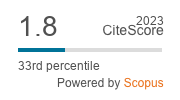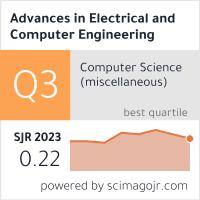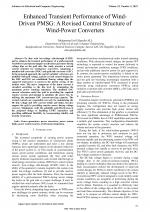| 2/2022 - 8 |
Enhanced Transient Performance of Wind-Driven PMSG: A Revised Control Structure of Wind-Power ConvertersALI, M. A. S. |
| Extra paper information in |
| Click to see author's profile in |
| Download PDF |
Author keywords
generators, power converters, power system faults, power system security, wind energy integration
References keywords
wind(19), energy(19), system(15), power(14), control(14), voltage(9), grid(9), systems(8), pmsg(8), generator(7)
Blue keywords are present in both the references section and the paper title.
About this article
Date of Publication: 2022-05-31
Volume 22, Issue 2, Year 2022, On page(s): 61 - 70
ISSN: 1582-7445, e-ISSN: 1844-7600
Digital Object Identifier: 10.4316/AECE.2022.02008
Web of Science Accession Number: 000810486800008
SCOPUS ID: 85131727947
Abstract
To deal with low-voltage ride-through (LVRT) and to enhance the transient performance of a grid-connected wind-driven permanent-magnet synchronous generator during voltage dips on the grid side, this study presents a revised control structure for wind-power converters, comprising a machine-side converter (MSC) and grid-side converter (GSC). In the proposed approach, the control variables references are modified with grid voltage, and the revised control designs for the MSC and GSC are established. During voltage dips, the captured wind power is stored as the kinetic energy of the turbine rotor. The active component of the stator current is curtailed according to the dip level by terminating the maximum power tracking operation. The modified GSC current references assist the grid in providing the required reactive current and attempt to minimize the power loss by utilizing the maximum GSC current-carrying capacity. The revised controls are responsible not only for maintaining the DC-link voltage and GSC current within safe limits, but also support the grid in providing reactive power during voltage recovery. Simulations verify the suitability and effectiveness of the proposed design in handling LVRT operations and providing additional flexibility by incorporating stability and security constraints. |
| References | | | Cited By «-- Click to see who has cited this paper |
| [1] M. A S. Ali, "Utilizing active rotor-current references for smooth grid connection of a DFIG-based wind-power system," Advances in Electrical and Computer Engineering, vol. 20, no. 4, pp. 91-98, 2020. [CrossRef] [Full Text] [Web of Science Times Cited 9] [SCOPUS Times Cited 11] [2] M. A. S. Ali, K. K. Mehmood, S. Baloch, C. H. Kim, "Modified rotor-side converter control design for improving the LVRT capability of a DFIG-based WECS," Electric Power Systems Research, vol. 186, p. 106403, 2020. [CrossRef] [Web of Science Times Cited 41] [SCOPUS Times Cited 53] [3] M. A S. Ali, "Step towards enriching frequency support from wind-driven permanent-magnet synchronous generator for power system stability," Advances in Electrical and Computer Engineering, vol. 22, no. 1, pp. 77-86, 2022. [CrossRef] [Full Text] [SCOPUS Times Cited 6] [4] M. A. S. Ali, "LMI-based state feedback control structure for resolving grid connectivity issues in DFIG-based WT systems," Eng, vol. 2, no. 4, pp. 562-591, 2021. [CrossRef] [Web of Science Times Cited 3] [SCOPUS Times Cited 3] [5] M. A S. Ali, K. K. Mehmood, J. S. Kim, C. H. Kim, "ESD-based Crowbar for Mitigating DC-link Variations in a DFIG-based WECS," In: International Conference on Power System Transients, Perpignan, France, pp. 1-6, 2019 [6] M. Firouzi, G. B. Gharehpetian, "LVRT performance enhancement of DFIG-based wind farms by capacitive bridge-type fault current limiter," IEEE Transactions on Sustainable Energy, vol. 9, no. 3, pp. 1118-1125, 2018. [CrossRef] [Web of Science Times Cited 88] [SCOPUS Times Cited 113] [7] M. J. Dehkordi, S. V. Zadeh, J. Mohammadi, "Development of a combined control system to improve the performance of a PMSG-based wind energy conversion system under normal and grid fault conditions," IEEE Transactions on Energy Conversion, vol. 34, no. 3, pp. 1287-1295, 2019. [CrossRef] [Web of Science Times Cited 58] [SCOPUS Times Cited 77] [8] O. P. Mahela, N. Gupta, M. Khosravy, N. Patel, "Comprehensive overview of low voltage ride through methods of grid integrated wing generator," IEEE Access, vol. 7, pp. 99299-99326, 2019. [CrossRef] [Web of Science Times Cited 141] [SCOPUS Times Cited 192] [9] M. A. S. Ali, K. K. Mehmood, C. H. Kim, "Power system stability improvement through the coordination of TCPS-based damping controller and power system stabilizer," Advances in Electrical and Computer Engineering, vol. 17, no. 4, pp. 27-36, 2017. [CrossRef] [Full Text] [Web of Science Times Cited 10] [SCOPUS Times Cited 10] [10] H. Geng, L. Liu, R. Li, "Synchronization and reactive current support of PMSG-Based wind farm during severe grid fault," IEEE Transactions on Sustainable Energy, vol. 9, no. 4, pp. 1596-1604, 2018. [CrossRef] [Web of Science Times Cited 148] [SCOPUS Times Cited 200] [11] M. F. Kangarlu, E. Babei, F. Blaabjerg, "A comprehensive review of dynamic voltage restorer," International Journal of Electrical Power and Energy System, vol. 92, pp. 135-155, 2019. [CrossRef] [Web of Science Times Cited 111] [SCOPUS Times Cited 159] [12] Z. Salama, H. S. Aly, M. M. Abdel-Akher, M. et al., "Frequency and voltage control of microgrid with high WECS penetration during wind gusts using superconducting magnetic energy storage," Electrical Engineering, vol. 101, pp. 771-786, 2019. [CrossRef] [Web of Science Times Cited 28] [SCOPUS Times Cited 33] [13] C. Huang, X. Y. Xiao, Z. Zheng, Y. Wang, "Cooperative control of SFCL and SMES for protecting PMSG-Based WTGs under grid faults," IEEE Transactions on Applied Superconductivity, vol. 29, no. 2, p. 5601106, 2019. [CrossRef] [Web of Science Times Cited 70] [SCOPUS Times Cited 53] [14] M. N. Musarrat, A. Fekih, "A fractional order sliding mode control-based topology to improve the transient stability of wind energy systems," International Journal of Electrical Power and Energy System, vol. 133, p. 107306, 2021. [CrossRef] [Web of Science Times Cited 19] [SCOPUS Times Cited 33] [15] M. K. Dcsoglu, O. Ozkaraca, U. Guvenc, "Novel active-passive compensator-supercapacitor modeling for low-voltage ride-through capability in DFIG-based wind turbines," Electrical Engineering, vol. 101, pp. 1119-1132, 2019. [CrossRef] [Web of Science Times Cited 15] [SCOPUS Times Cited 15] [16] M. N. Musarrat, A. Fekih, M. R. Islam, "An improved fault ride through scheme and control strategy for DFIG-based wind energy systems," IEEE Transactions on Applied Superconductivity, vol. 31, no. 8, p. 5401906, 2021. [CrossRef] [Web of Science Times Cited 21] [SCOPUS Times Cited 31] [17] M. A. S. Ali, K. K. Mehmood, J. K. Park, C. H. Kim, "Battery energy storage system-based stabilizers for power system oscillations damping," Journal of the Korean Institute of Illuminating and Electrical Installation Engineers, vol. 10, pp. 75-84, 2016. [CrossRef] [18] P. Xing, L. Fu, G. Wang, Y. Zhang, "A composite control method of low-voltage ride through for PMSG-based wind turbine generation system," IET Generation, Transmission and Distribution, vol. 12, no. 1, pp. 117-125, 2018. [CrossRef] [Web of Science Times Cited 45] [SCOPUS Times Cited 53] [19] M. Wang, Y. Hu, W. Zhao, Y. Wang, G. Chen, "Application of modular multilevel converter in medium voltage high power permanent magnet synchronous generator wind energy conversion systems," IET Renewable Power Generation, vol. 10, no. 16, pp. 824-833, 2016. [CrossRef] [Web of Science Times Cited 72] [SCOPUS Times Cited 86] [20] L. S. Barros, C. M. V. Barros, "An internal model control for enhanced grid-connection of direct-driven PMSG-based wind generators," Electric Power Systems Research, vol. 51, pp. 440-450, 2017. [CrossRef] [Web of Science Times Cited 40] [SCOPUS Times Cited 55] [21] O. A. Lara, N. Jenkins, J. Ekanayake, P. Cartwright, F. Hughes, Wind energy generation: Modeling and Control, Wiley, 2009 [22] N. H. Saad, A. A. El-Sattar, M. E. Marei, "Improved bacterial foraging optimization for grid connected wind energy conversion system based PMSG with matrix converter," Ain Shams Engineering Journal, vol. 9, no. 4, pp. 2183-2193, 2018. [CrossRef] [Web of Science Times Cited 20] [SCOPUS Times Cited 28] [23] Z. M. Hailemariam, R. Leidhold, G. T. Tesfamariam, Real-time dc-link voltage control of 5-kW PMSG-based wind turbine generator through a test-rig," Electrical Engineering, vol. 103, pp. 1869-1880, 2021. [CrossRef] [Web of Science Times Cited 1] [SCOPUS Times Cited 2] [24] R. Basak, G. Bhuvaneswari, R. Pillai, "Low-voltage ride-through of a synchronous generator-based variable speed grid-interfaced wind energy conversion system," IEEE Transactions on Industry Applications, vol. 56, no. 1, pp. 752-762, 2020. [CrossRef] [Web of Science Times Cited 43] [SCOPUS Times Cited 64] [25] M. A. S. Ali, K. K. Mehmood, C. H. Kim, "Full operational regimes for SPMSG-based WECS using generation of active current references," International Journal of Electrical Power and Energy System, vol. 112, pp. 428-441, 2019. [CrossRef] [Web of Science Times Cited 10] [SCOPUS Times Cited 12] [26] M. A. S. Ali, K. K. Mehmood, S. Baloch, C. H. Kim, "Wind-speed estimation and sensorless control for SPMSG-based WECS using LMI-based SMC," IEEE Access, vol. 8, pp. 26524-26535, 2020. [CrossRef] [Web of Science Times Cited 16] [SCOPUS Times Cited 20] [27] X. Q. Zhang, J. He, Y. Xu, Z. Hong, Y. Chen, K. Strunz, "Average-value modeling of direct-driven PMSG-based wind energy conversion systems," IEEE Transactions on Energy Conversion, pp. 1-1, 2021. [CrossRef] [Web of Science Times Cited 19] [SCOPUS Times Cited 40] [28] Y. Shen, D. Ke, Y. Sun, D. S. Kirschen, W. Qiao, X. Deng, "Advanced auxiliary control of an energy storage device for transient voltage support of a doubly fed induction generator," IEEE Transactions on Sustainable Energy, vol. 7, no. 1, pp. 63-76, 2016. [CrossRef] [Web of Science Times Cited 47] [SCOPUS Times Cited 62] [29] F. Blaabjerg, D. Xu, W. Chen, N. Zhu, Advanced control of doubly fed induction generator for wind power systems, Wiley-IEEE, 2018 Web of Science® Citations for all references: 1,075 TCR SCOPUS® Citations for all references: 1,411 TCR Web of Science® Average Citations per reference: 36 ACR SCOPUS® Average Citations per reference: 47 ACR TCR = Total Citations for References / ACR = Average Citations per Reference We introduced in 2010 - for the first time in scientific publishing, the term "References Weight", as a quantitative indication of the quality ... Read more Citations for references updated on 2025-06-05 00:07 in 175 seconds. Note1: Web of Science® is a registered trademark of Clarivate Analytics. Note2: SCOPUS® is a registered trademark of Elsevier B.V. Disclaimer: All queries to the respective databases were made by using the DOI record of every reference (where available). Due to technical problems beyond our control, the information is not always accurate. Please use the CrossRef link to visit the respective publisher site. |
Faculty of Electrical Engineering and Computer Science
Stefan cel Mare University of Suceava, Romania
All rights reserved: Advances in Electrical and Computer Engineering is a registered trademark of the Stefan cel Mare University of Suceava. No part of this publication may be reproduced, stored in a retrieval system, photocopied, recorded or archived, without the written permission from the Editor. When authors submit their papers for publication, they agree that the copyright for their article be transferred to the Faculty of Electrical Engineering and Computer Science, Stefan cel Mare University of Suceava, Romania, if and only if the articles are accepted for publication. The copyright covers the exclusive rights to reproduce and distribute the article, including reprints and translations.
Permission for other use: The copyright owner's consent does not extend to copying for general distribution, for promotion, for creating new works, or for resale. Specific written permission must be obtained from the Editor for such copying. Direct linking to files hosted on this website is strictly prohibited.
Disclaimer: Whilst every effort is made by the publishers and editorial board to see that no inaccurate or misleading data, opinions or statements appear in this journal, they wish to make it clear that all information and opinions formulated in the articles, as well as linguistic accuracy, are the sole responsibility of the author.



